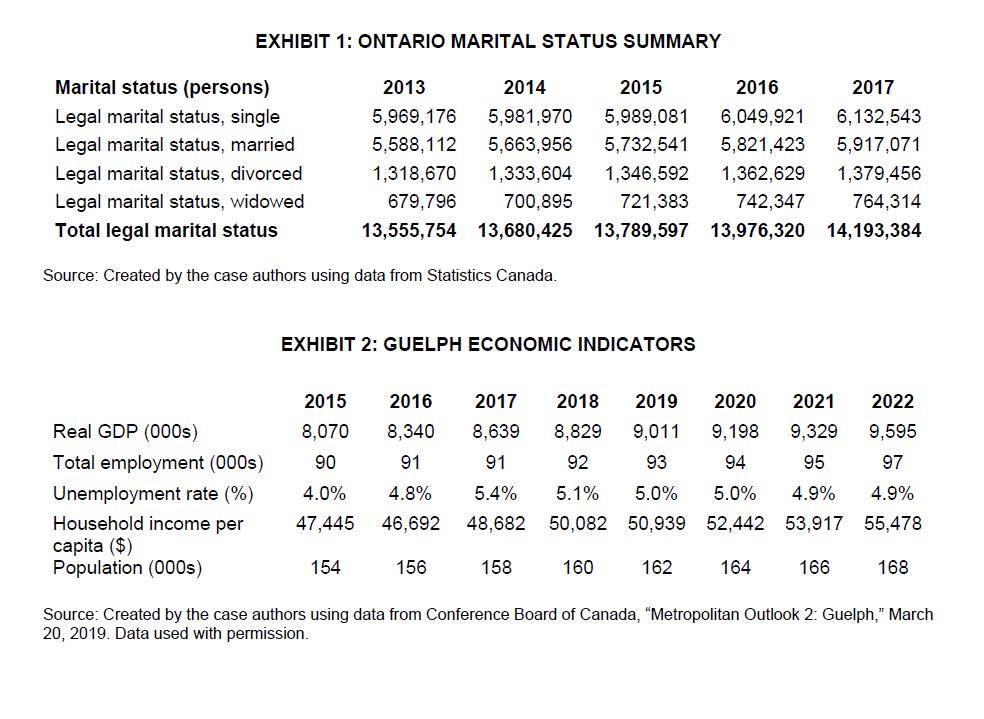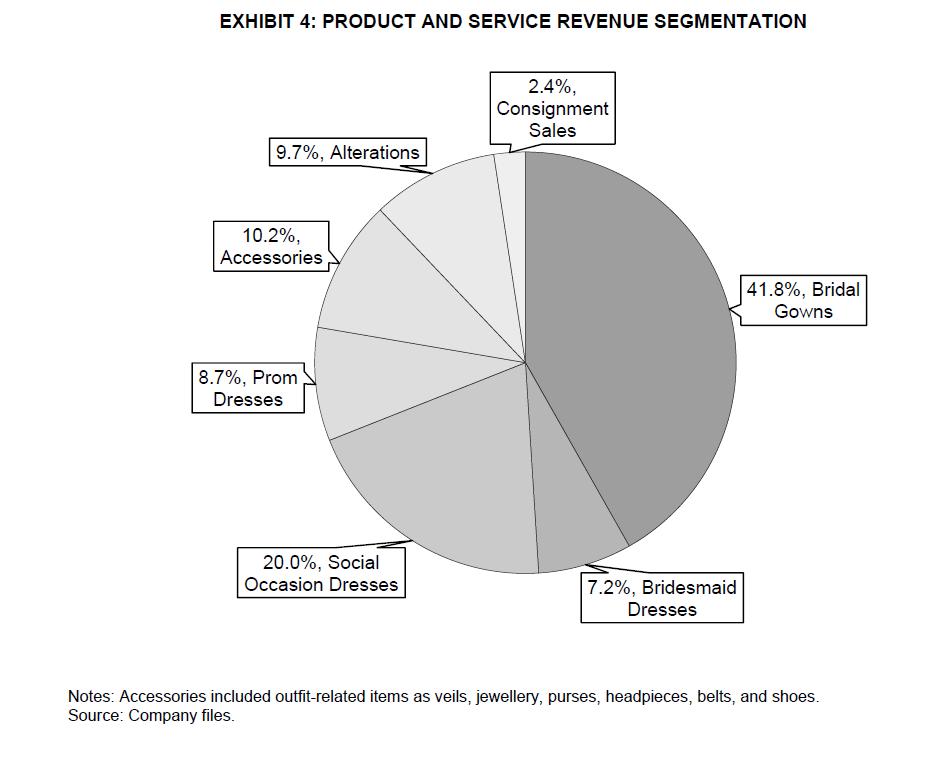Crme Couture was located inside the Old Quebec Street Mall, in the heart of Guelph, Ontario (see Exhibit 3). Positioned as an upscale bridal operator,
Crème Couture was located inside the Old Quebec Street Mall, in the heart of Guelph, Ontario (see Exhibit 3). Positioned as an upscale bridal operator, Crème Couture provided alteration services21 as well as a diverse portfolio of wedding-related products including bridal gowns, bridesmaid dresses, social occasion apparel, prom dresses, and accessories (see Exhibit 4). Sandra was selective as to where she sourced her inventory, independently selecting and curating fashion designers from all over the world. To remain upto-
date with fashion trends, she attended annual fashion conventions throughout Europe and North America.
Sandra made it a priority to meet with each designer in order to maintain a positive working relationship as well as to secure regional exclusivity rights for the apparel. The average Crème Couture wedding dress sold for approximately $1,500. Any inventory that could not be sold after several years was passed along to a consignment store.22 Due to the logistical complexities associated with retailing online, Crème Couture sold inventory in-store only.
One of Crème Couture’s longstanding goals was to be renowned for its customer service. Sandra strongly believed that although the product was important to the consumer, the purchasing experience was what really drove sales. Many brides had noted that there was a societal standard to achieve “the perfect wedding,” creating
unnecessary pressures during the wedding planning process.23 With this in mind, Sandra invested a large amount of capital in establishing an elegant, comfortable, and relaxing atmosphere. Among other amenities, Crème Couture offered private one-on-one bridal consultations, conducted all apparel appointments on a first-name basis, provided sparkling water during appointments and celebrated all purchases with complimentary bridal gift bags. Crème Couture also made it a priority to give back to the community by participating in local charity
fashion shows and frequently donating wedding dresses to those in need.
In addition to the community outreach, Crème Couture utilized a variety of advertising media. Radio, Facebook, and Instagram were used to promote in-store products, while popular wedding magazines featured many of Crème Couture’s current fashion lines. Sandra also coordinated an annual fashion show within the Old Quebec Street Mall to highlight new prom dress inventory. Expenditures for the FY 2018 prom fashion show totalled $6,045. Finally, Sandra advertised her wedding dresses at 14 bridal conventions throughout the year. Each bridal convention spanned over two days and allowed brides-to-be to browse the many different bridal retailers and fashion lines.24 All other advertising expenditures would be allocated as a proportion of total applicable revenues.
Nevertheless, many operational issues plagued the business. Clothing racks were cluttered with an excessive amount of inventory and as a result, staff struggled to locate dresses. Additionally, the bridal boutique was not as efficient as Sandra had hoped, operating at a 15 per cent utilization rate and servicing approximately 500 brides per year.25 Sandra knew that something had to be done in order to free up space, increase the bridal utilization rate, and ultimately achieve her long-term growth goals.
FINANCIAL ANALYSIS
Sandra wanted to evaluate the performance of each revenue segment before creating her expansion strategy. She needed to determine which expenditures were direct and which were indirect to identify expenditures that should be allocated to the consignment sales segment. To do so, she gathered information pertaining to the company’s financial performance (see Exhibits 5 and 6). Sandra concluded that any expense that could not be easily traced to a specific revenue stream would be spread evenly among all applicable segments.
The travel expense included Sandra’s purchasing excursions, as well as the cost to transport equipment to and from the bridal conventions. Transportation to and from the bridal conventions cost a total of $6,478. Sandra also travelled to Atlanta, Georgia once a year to browse new prom fashion lines and designers, which cost a total of $1,500. The remaining purchasing excursion costs could not be allocated to a specific segment and thus were divided among all product segments, except prom dresses, in proportion to the cost
of goods sold for each product segment.
In addition to Sandra, Crème Couture employed two bridal sales consultants and two general sales employees. Sandra oversaw and indirectly worked on all components of the business. The bridal sales consultants worked on an as-needed basis and focused exclusively on fitting and altering all bridal and bridesmaid dresses, whereas the general sales employees oversaw the remaining in-store apparel segments. In fiscal 2018, the bridal sales consultants earned a total of $40,534, $6,982, and $9,406 for the bridal gowns, bridesmaid dresses,
and alterations segments, respectively. Similarly, the general sales employees were paid a total of $19,394 for the social occasion dress segment, $8,436 for the prom dress segment, and $9,891 for the accessories segment.
All salaries and wages were allocated as a proportion of total applicable revenues.
The insurance policy pertained to all inventory and equipment that Crème Couture owned. Sandra estimated that 50 per cent of the total insurance policy would be allocated to the bridal gown segment, whereas the remainder would be split evenly among the remaining product segments. Rent and utilities were allocated based upon square footage. The bridal boutique occupied 950 of the total 1,900 square feet, whereas bridesmaid, prom, and social occasion apparel each occupied 200 square feet. The rest of the rent expenditure was split evenly between the remaining in-store revenue segments.
Sandra did not believe that office supplies, telephone, and Internet expenditures should be allocated to consignment sales and therefore spread them evenly among all in-store revenue segments. Finally, Sandra had taken out a bank loan to purchase Crème Couture in 2013, and the interest and bank expenses could be spread evenly among all segments.
FUTURE EXPANSION
As she examined the company’s current state, Sandra began to establish a detailed expansion strategy that would best position Crème Couture for future growth. Specifically, she wanted to understand which revenue segments were most and least profitable, and as a result, which warranted further investment. She wanted her expansion strategy to align with her goals of freeing up inventory space, attracting more clientele, providing exceptional customer service, and increasing net profit.



Question
1. Quantitative analysis: Calculation of profit by operating segment (as identified by Ms. Sandra) and analysis/implications of the calculations?
2. Detailed consideration of a minimum of three alternatives (should include pros/cons of each
based on established criteria)
EXHIBIT 1: ONTARIO MARITAL STATUS SUMMARY Marital status (persons) 2013 2014 2015 2016 2017 Legal marital status, single 5,969,176 5,981,970 5,989,081 6,049,921 6,132,543 Legal marital status, married 5,588,112 5,663,956 5,732,541 5,821,423 5,917,071 Legal marital status, divorced 1,318,670 1,333,604 1,346,592 1,362,629 1,379,456 Legal marital status, widowed 679,796 700,895 721,383 742,347 764,314 Total legal marital status 13,555,754 13,680,425 13,789,597 13,976,320 14,193,384 Source: Created by the case authors using data from Statistics Canada. EXHIBIT 2: GUELPH ECONOMIC INDICATORS 2015 2016 2017 2018 2019 2020 2021 2022 Real GDP (000s) 8,070 8,340 8,639 8,829 9,011 9,198 9,329 9,595 Total employment (000s) 90 91 91 92 93 94 95 97 Unemployment rate (%) 4.0% 4.8% 5.4% 5.1% 5.0% 5.0% 4.9% 4.9% Household income per capita ($) Population (000s) 47,445 46,692 48,682 50,082 50,939 52,442 53,917 55,478 154 156 158 160 162 164 166 168 Source: Created by the case authors using data from Conference Board of Canada, "Metropolitan Outlook 2: Guelph," March 20, 2019. Data used with permission.
Step by Step Solution
3.41 Rating (167 Votes )
There are 3 Steps involved in it
Step: 1
1 Assume that you are consulting for Ms Sandra and she has presented all information in the case to you What does she want your help with What has Ms Sandra identified as the longterm goals for her co...
See step-by-step solutions with expert insights and AI powered tools for academic success
Step: 2

Step: 3

Ace Your Homework with AI
Get the answers you need in no time with our AI-driven, step-by-step assistance
Get Started


